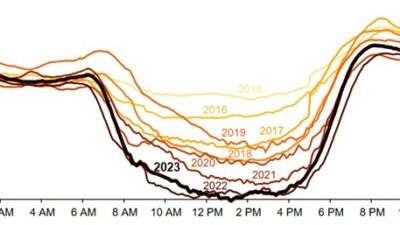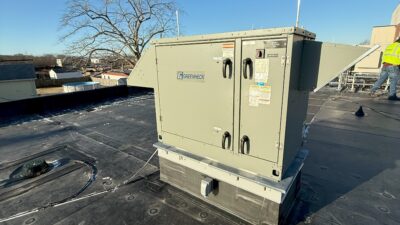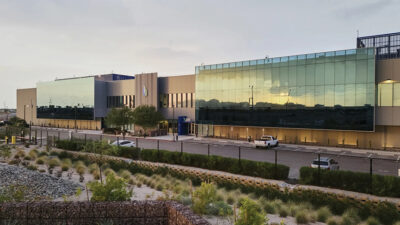Our panel discusses paralleling and proper sizing for generators, considerations for subtransient reactance in critical environments, and accurately matching automatic transfer switches and generators.
View the full story, including all images and figures, in our monthly digital edition
CSE: What are the risks when paralleling generators? What’s your top tip for control?
Keith Lane : Paralleling generators provides for several advantages. Two or more generators paralleled together can be used to provide added generator capacity. This arrangement is called “isolated bus” and does not incorporate the utility feeder into the system. The generator distribution is connected to the utility power downstream at an automatic transfer switch (ATS). Closed-transition paralleled generator systems integrate multiple generators and the serving power utility into a single switchgear. These systems can provide a number of advantages, particularly for large and high-power systems.
There is a reasonable apprehension in the industry with regard to the single point of failure that the utility and generator closed transition paralleling gear can produce. This concern can be minimized by providing a tie breaker between generator systems that will permit one of the generator system paralleling switchboards to feed through the other generator system paralleling switchboard in the occurrence of a single generator system switchboard failure.
Kevin Voss : The risks associated with paralleling generators are damage to equipment due to closing generator breakers out of phase, with large voltage mismatch between the generator and the electrical system, and grounding incompatibility. Also, induced harmonic currents between paralleled generators are risky when generator pitch is not matched. Tips for paralleling generator controls would be to always specify generator auto-synchronizing and governor and exciter control systems as a packaged system with the generator.
Gary Olson : I think the biggest risks are self-inflicted. Designers have a tendency to make things more complicated than they need to be in the quest for “redundant everything” to achieve better reliability. Over the years, I have seen many systems with multiple levels of backup that are so complex that when a failure occurs, no operator knows how to implement the backups. I am a fervent believer in simplicity being a key driver to reliability; especially over the long 30-year life span of a typical facility. Integrated paralleling control technologies are available today that make paralleled generator sets, in a practical sense, no more complex than nonparalleled gensets. Using these technologies in the optimum way almost eliminates the risks that have historically been present in paralleling applications.
Al Prosser : There are several risks to avoid when paralleling generators. Most importantly, be sure to consider including a robust multisync interlock control to prevent multiple generators from simultaneously closing to a dead bus.
CSE: What are your best practice tips for properly sizing generators for various applications? How do you apply ratings (standby, prime, or continuous)? How do you plan for growth?
Voss : To properly size a continuous-duty generator, many factors must be known about the system. The critical factors include knowing power quality requirements for the various loads served by the generator, load duty cycle, largest motor or load step on the system, and understanding starting requirements of the loads. For example, generator manufacturers would typically consider a 30% maximum voltage dip acceptable during a load step, but fire pumps are limited to 15% per NFPA 20 . This level of voltage is not acceptable to many electrical components and power supplies. Plans for growth include modular designs, adequate physical space for future expansion, available bus capacity, and isolation requirements.
Olson : First, you need to understand what the loads are likely to be and how they’re likely to change over time; this is difficult. Many customers are reluctant to pay a designer to do this job; however, they then pay over the course of time. Next, you need to model the load in a good sizing tool that accounts for the dynamic nature and particular characteristics of different loads.
Finally, pick the right genset (engine/alternator) size based on expected operational hours, environmental restrictions, and load levels. Pay attention to the actual meaning of standby, prime, and continuous in the ISO standards, and to the equipment derating factors in the manufacturers’ literature that describe actual performance based on site conditions.
Prosser : In North America, the best practice is to follow the ISO Standard 8528 for diesel-fueled continuous prime applications and select the highest load factor product matched to the facility’s load requirements.
Lane : Once an engineer has identified the anticipated environment in which the generator is going to be located, additional sizing constraints must be considered. Most generators that are used for life safety and legally required systems as well as some optional loads that are intended to be used in the event of unusual utility power outage are considered standby rated. The standby rating is typically rated to be run 100 hr. per year, have a load factor of 60% or less, and have a typical peak demand of 80% of standby rated kW with 100% available for the duration of an emergency outage.
CSE: How do you properly consider the subtransient reactance of a generator in your design of critical environments?
Olson : Subtransient reactance impacts the ability of a generator to work as much like a utility as possible so system loads can work normally when running on a generator set. The objective of an alternator selection process is to get as close to a utility capability as possible. From a generator supplier’s perspective, that means that a machine with relatively low subtransient reactance is needed. Such machines usually cost a bit more, though, and because subtransient reactance is not easy to understand or measure in the field, it’s often overlooked or ignored. It is possible to get a machine with subtransient reactance that’s too low, especially in larger paralleling applications, so it’s necessary to understand exactly what you’re doing when you select an alternator.
Lane : A generator providing standby power for a data center or critical environment can be exposed to significant levels of total harmonic distortion (THD) from the significant number of nonlinear loads. In these environments, it is critical to specify a generator with a low alternator subtransient reactance. Preferably, the subtransient reactance is in the 8% to 12% range. A generator with a high subtransient reactance in an environment with high THD current will produce a high THD voltage waveform that will affect the entire electrical distribution system. Soft starters or variable frequency drives (VFDs) can reduce the starting inrush current and kVA to half of that of an across-the-line starter.
On the downside, these devices also use silicon controlled rectifiers to chop up the ac waveform and will provide a nonlinear waveform. This nonlinear waveform (harmonics) will cause voltage distortion across the reactor of the generator and can cause unacceptable transient performance. Alternator subtransient reactance describes the instantaneous response of an alternator to a large overload.
The subtransient reactance is important in that it defines the performance of a generator set to deal with harmonics and to deal with the starting of large motors. The engineer must also be aware that, although a lower subtransient reactance is preferred, it will also result in a higher fault current. In most cases, the utility will provide for higher fault currents than the generator except when paralleling multiple generators. In the case of multiple generators, the subtransient reactance can have a significant effect on the fault current within the electrical distribution system.
Prosser : The IEEE standards provide guidance for alternator selection based on THD from the generator and application to load and fault duty. Balance the needs with the THD from the loads, generator, and voltage regulator and with the short-circuit capabilities of the switchgear and other equipment based on the results of a properly analyzed fault and protective relaying study.
CSE: Generator and ATS—how do you make the perfect match for standby systems?
Prosser : In general, they should be sized per NEC , with a consideration of the facility’s needs for the switching methods required with emphasis on load priorities, grounding, and transient performance to meet the load needs. Application codes and standards such as NFPA 110 and others also have requirements that affect the overall design of an emergency system with generator and ATS.
Lane : It is possible to have a single generator feed life safety and non-life-safety loads. The NEC will allow an alternate power source to supply emergency, legally required standby, and optional loads, where automatic selective load pickup and load shedding as needed are implemented to ensure adequate power to life safety, legally required standby, and optional loads, in that order. This can be achieved by providing a separate ATS for each of the three branches of loads (life safety, legally required standby, optional).
One way to achieve load shedding is to require standby and optional ATSs to have a center off position and a load shed relay. When the generator is close to an overload condition, it will send a signal to the load shed relays to remove the non-life-safety ATSs and non-life-safety loads and ensure that the life safety loads remain on emergency power. As a side benefit, the three branches of ATSs can provide convenient load stepping during generator startup. This will typically reduce the required size of the generator. The transfer switches can be timed per the NEC to start the life safety loads within 10 sec. and the standby loads within 60 sec.
Voss : Matching an ATS to a standby generator is all about application. The various codes and standards for standby systems dictate the rules for the switches, but the challenge is making sure to apply the correct set of requirements. If defined as a legally required standby system by the NEC or if the system is being applied to an industrial process, the standby power source will have different design requirements.
CSE: What are some of the design considerations with ATSs and grounding and bonding?
Prosser : Issues include when to apply service entrance ratings on generator sets, specifically coordinating with existing facility and equipment grounding systems. For certain mission critical and medium voltage applications, when to apply high and low resistance grounding schemes is an issue. Another issue is when to apply the specific ATS technologies to suit grounding schemes.
Voss : The most common mistake on paralleling generators is not properly coordinating the generator grounding method with the system grounding method. Electrical systems and generators can be configured in a multitude of ways including solidly grounded, low-impedance ground, high-impedance ground, reactance grounded, or ungrounded.
The most common method for fixing a mismatched grounding system would be to install an isolation transformer between the generator and the system. The transformer can provide a separately derived grounding system and can ultimately resolve a mismatched ground system.
Lane : In a typical three-phase electrical distribution system, the designer has the choice between three- and four-pole transfer switches. There are certain circumstances where a four-pole transfer switch will be required. A four-pole transfer switch is typically required where the distribution system has two or more levels of ground fault sensing and two or more ATSs. Per the NEC, ground fault protection is required on solidly grounded equipment 277/480 V-rated 1,000 A or more. Where a single level of ground fault is required by the NEC, hospitals will require a second level of ground fault protection to ensure service continuity during a ground fault on a branch feeder.
Although not required by code, other critical facilities may opt for multiple levels of ground fault protection to minimize the effect of a short to ground. In these cases of multiple levels of ground fault and of multiple transfer switches, a four-pole transfer switch is required. If the neutral is not switched, neutral current due to unbalanced loading or nonlinear loads can split in the parallel paths and cause nuisance tripping of the ground fault. A four-pole transfer switch switches the neutral; a three-pole transfer switch does not. If the generator main breaker is rated at 1,000 A or more and is at 480 V three-phase, per the NEC, ground fault indication is required.
Olson : There are two simple rules you need to follow:
-
Have only one neutral-to-ground bonding point on any neutral bus in a facility
-
Locate ground fault sensors downstream from the bonding point.
A complicating factor is different generator set suppliers have different practices with respect to whether the neutral-to-ground bond is provided and how. A designer should consider these rules in the design of the facility, and then make sure that the facility drawings specifically show all the bonding points. All the sources and transformers in the system then need to be checked during commissioning. Equipment should be labeled to indicate when a bonding point is present, and when an interconnected system (like a generator) uses the same bonding point.
CSE: What are the most important maintenance and commissioning issues for standby generators that designers need to plan for?
Lane : As electrical distribution systems get more complex, the commissioning process becomes a higher priority. It is important to confirm that the entire standby electrical distribution system functions appropriately as a whole. Many functions of the standby system control logic must be set properly during startup. Additionally, the engineer of record or the commissioning agent must verify these settings.
Most ATSs have multiple time settings including time delay start, time delay transfer, time delay retransfer, program transition, time delay cool down, and an exercise clock. Some of these settings will be standard factory settings, but many are going to be specific to the project.
External parameters such as reliability of the serving utility, size and number of motor loads in the electrical distribution system, allowed false starts of the generator, and exercise requirements will play a role into the actual settings of these parameters.
Voss : The most important maintenance issue for standby generators is the requirement to regularly test the generator. Routine maintenance and operation tests are required for legally required standby systems per the NEC. Depending on the system configuration, it may be inconvenient to perform the test during normal operation. Designers of standby generation systems need to follow the applicable standards, including NEC and various NFPA standards.
Designers should also work with operating personnel to ensure that the design implementation allows for proper testing that does not negatively impact the normal operation. Load banks are a simple option that provide flexibility and are easy to integrate. Designers should also consider providing connection to temporary portable or alternate sources when the generator is unavailable.
Olson : It’s common knowledge that battery system failures are at the core of most generator set failures. Many of these could be avoided by making sure that a proper battery charger is installed. The battery charger needs to be able to float to zero-net charge on the batteries; it needs to be sized correctly per NFPA 110 (most are too small); and it needs to have ambient temperature compensation in the charge rate. It’s also important that the fuel system design is correct for the engine that is installed, and this can change a bit from engine to engine. Proper maintenance, including battery bank replacement, is critical. If that isn’t done, the system will be unreliable within two or three years of installation.
Prosser : Fuel filtration, batteries, and load testing are critical components. Fuel filtration to reduce the possibility of containments in the engine, battery maintenance to ensure a successful generator start every time, and periodic testing of the system helps reduce the possibility of a failure.
Participants
Keith Lane, PE, RCDD, LC, LEED AP President, Lane Coburn & Assocs. Seattle
Gary L. Olson Director of Power Systems Development, Cummins Power Generation. Minneapolis
Al Prosser Director of Sales and Application Engineering, MTU Onsite Energy. Mankato, Minn.
Kevin Voss, PE Senior Electrical Engineer, Electrical and Controls Dept. Manager, Stanley Consultants. Muscatine, Iowa



